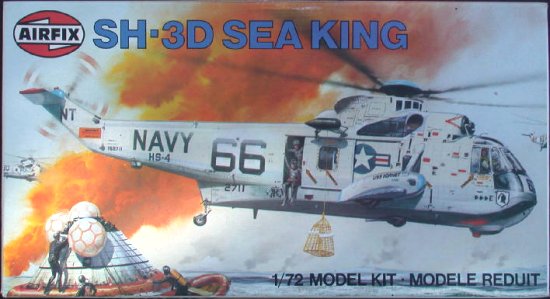
|
KIT: |
Airfix 1/72 SH-3D Sea King |
|
KIT # |
3010 |
|
PRICE: |
10 Euros from eBay |
|
DECALS: |
See review |
|
REVIEWER: |
|
|
NOTES: |
Overall rating: 10 out of 10 points for sentimentality and fun! |

|
HISTORY |
I won´t bother with telling lengthy stories about the legendary helicopter workhorse, the Sea King, which was used for a full 35 years in various roles and versions, including ASW, utility, SAR, executive transport (still today) and many others. I guess the H-3 or S-61 must be one of the best known helicopters in the world, and this kit´s subject will probably be the best known individual airframe of the series.
During the American space program, the designers chose to have the command modules recovered from sea rather than from dry land (the Soviets decided to do it the other way round), so each mission until Skylab ended with the capsule´s recovery by a USN helicopter from a selected touch-down area in the pacific. Five of these recoveries were performed by a SH-3D from HS-4 Black Knights with the BuNo 152711 and the side number 66. #66 took charge of recovering Apollo 8, 10, 11, 12, 13. After retirement, it should have been presented to the Smithsonian National Air and Space museum. Unfortunately it crashed in 1975, so it was never displayed in the museum.
Now this is yet another example of reliving my childhood, at least the part spent building plastic models. I already referred to this in my preview on the Airfix Lunar Module, and this kit was equally up to date back then in the heyday of the Apollo program, just as - for instance - the Orion spaceliner from the movie 2001- A Space Odyssey kitted by Airfix at the same time.
I clearly remember watching on TV the big white over gray helicopter with the fat 66 picking up the astronauts from the pacific ocean after much anticipation during re-entry, and USS Hornet must have been the first carrier name I knew. The space program was immensely popular, and I´m afraid there was even a horrible German „Schlager“ song titled „Helicopter US Navy 66“, but I won´t take any vows on that. And I of course had to have that helicopter as a plaything – which I got, and it really was fun playing with it.
Now I´ve picked it up again, this time on ebay, and even at a less than ridiculous price (anyone out there got a Monogram 1/72 B-52 with X-15 at below 40$ for me - nah, just kidding...) I opened the shrink wrap, sniffed the plastic and fondled it a while. So here´s what you get:
|
THE KIT |
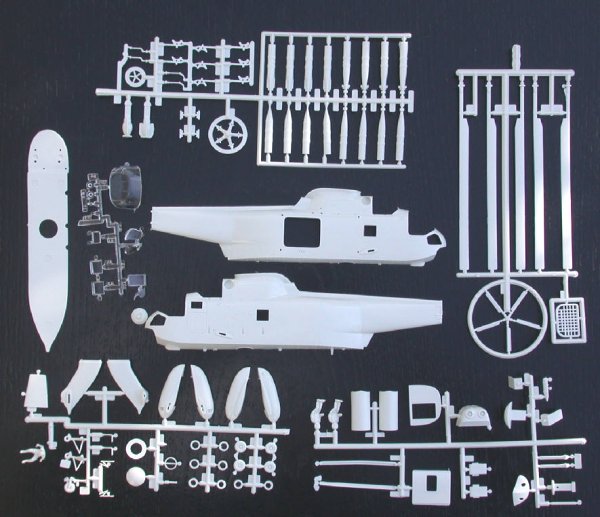
The box , copyrighted in 1980, contains 109 plastic parts, molded in white, including 11 clear parts. There are two options, one for the famous #66 of HS-4 from USS Hornet, the other #63 of HS-9 from USS Essex. The decals should be usable, yet they are by no means comprehensive (although I remember it looked a damn lot of decals in 1971 or so).
Instructions are adequate and easily undertsood, color callouts are - as to be expected in a kit from this age – in Airfix colors, but that shouldn´t pose a real problem.
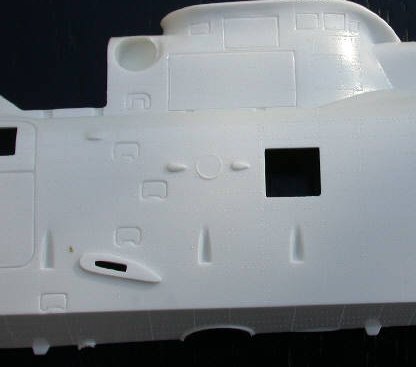 The plastic parts show a little flash,
some sink marks and also ejector pin marks, yet not on too conspicuous
locations. Surface detail is partly recessed around accesses yet mostly raised
and shows plenty of rivets. Two (identical) pilots are included as well as a
sitting astronaut for the recovery frame.
The plastic parts show a little flash,
some sink marks and also ejector pin marks, yet not on too conspicuous
locations. Surface detail is partly recessed around accesses yet mostly raised
and shows plenty of rivets. Two (identical) pilots are included as well as a
sitting astronaut for the recovery frame.
For the sub-hunting #63, the kit includes a dipping sonar (that can be ingeniously raised and lowered by turning the rotor – with working features – plus two times four explosive blobs to be placed on the torpedo shackles, myself being ignorant of the exact type of weapon.
Now we´ve come to the issue of accuracy, and I´ll just state it as it is since I won´t measure this kit with today´s standards (the more perfect a kit, the more heartbreaking errors are detected and lamented – must be some kind of Murphy´s law...)
Y´see, it´s like that: I only have the Squadron booklet as reference, plus what you can gather on the net. So if I take it for granted what I read there, it looks like this:
The SH-3D can be distinguished externally
from the A model by an enlarged horiziontal stabilizer with a bracing strut.
This wasn´t included in the kit, and the stabilizer is truly tiny, and without a
bracing strut. (Your editor would like to mention that the unbraced, small stab is
normal for an SH-3D. It wasn't until the more powerful SH-3G/H versions that the
larger braced stab was part of the
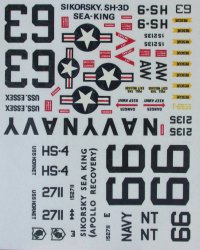 fit. See the image below.)
Moreover, the booklet states that the torpedo capacity was reduced to two from
four with the SH-3A, and you get four sets of shackles as already mentioned. So
you should really treat this kit as an A model.
fit. See the image below.)
Moreover, the booklet states that the torpedo capacity was reduced to two from
four with the SH-3A, and you get four sets of shackles as already mentioned. So
you should really treat this kit as an A model.
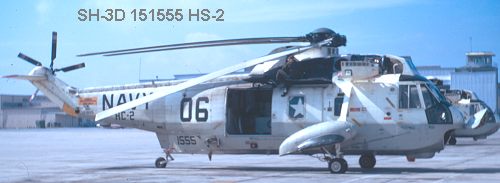
Now comes the second part: The squadron booklet says that the helicopters used for the Apollo recovery were utility helicopters devoid of any sub-hunting equipment, namely the torpedoes, the dipping sonar, sonabuoys and a MAD (Magnetic Anomaly Detector – or what did you think?) towed body. The SH-3D was delivered in these two versions to the Navy, and it makes perfect sense to use a helo with more space and less built-in equipment unnecessary for this particular mission.
So if you mean to do #66, you should replace the horizontal stabilizer and delete the ASW stuff, namely the dipping sonar, including its housing that runs through the otherwise empty inside of the fuselage, and you should fill the attachment points for the torpedo shackles. Several other little improvements might be more than a little helpful to the model´s appearance; I´d namely think of the distictive external antennae on the port side, and some more decals would also help.
|
CONCLUSIONS |
I can´t find any serious flaw in a 30-year old kit in that, and I´m looking forward to building it, although it might seem sacrilegious given its age. But then after are I´m a humble builder/assembler, although over time I´ve grown some kind of collector, too, yet I´d probably never just buy without intent to build ;-)
Have fun and build cool models,
FrankIf you would like your product reviewed fairly and quickly by a site that has well over 150,000 visitors a month, please contact me or see other details in the Note to Contributors.